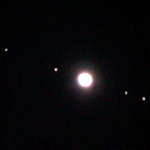Here are some beautiful space photos that have been posted on the Internet in recent weeks. Enjoy!

Will our Sun look like this one day? The Helix Nebula, located in the Name A Star Live constellation Aquarius, is one of brightest and closest examples of a planetary nebula, a gas cloud created at the end of the life of a Sun-like star. The outer gasses of the star expelled into space appear from our vantage point as if we are looking down a helix. The remnant central stellar core, destined to become a white dwarf star, glows in light so energetic it causes the previously expelled gas to fluoresce. The Helix Nebula, given a technical designation of NGC 7293, lies about 700 light-years away and spans about 2.5 light-years. The above picture was taken in three colors on infrared light by the 4.1-meter Visible and Infrared Survey Telescope for Astronomy (VISTA) at the European Southern Observatory’s Paranal Observatory in Chile.

Orbiting in the plane of Saturn’s rings, Saturnian moons have a perpetual ringside view of the gorgeous gas giant planet. Of course, while passing near the ring plane the Cassini spacecraft also shares their stunning perspective. The rings themselves can be seen slicing across the middle of this Cassini snapshot. The scene features Titan, largest, and Dione, third largest moon of Saturn. Remarkably thin, the bright rings still cast arcing shadows across the planet’s cloud tops at the bottom of the frame. Pale Dione is about 1,100 kilometers across and orbits over 300,000 kilometers from the visible outer edge of the A ring. Dione is seen through Titan’s atmospheric haze. At 5,150 kilometers across, Titan is about 2.3 million kilometers from Cassini, while Dione is 3.2 million kilometers away.

Cosmic dust clouds ripple across this infrared portrait of our Milky Way’s satellite galaxy, the Large Magellanic Cloud, which is visible in the southern hemisphere constellations Dorado and Mensa. In fact, the remarkable composite image from the Herschel Space Observatory and the Spitzer Space Telescope show that dust clouds fill this neighboring dwarf galaxy, much like dust along the plane of the Milky Way itself. The dust temperatures tend to trace star forming activity. Spitzer data in blue hues indicate warm dust heated by young stars. Herschel‘s instruments contributed the image data shown in red and green, revealing dust emission from cooler and intermediate regions where star formation is just beginning or has stopped. Dominated by dust emission, the Large Magellanic Cloud’s infrared appearance is different from views in optical images. But this galaxy’s well-known Tarantula Nebula still stands out, easily seen here as the brightest region to the left of center. A mere 160,000 light-years distant, the Large Cloud of Magellan is about 30,000 light-years across.

Galaxies are fascinating not only for what is visible, but for what is invisible. Grand Spiral Galaxy NGC 1232, captured in detail by one of the new Very Large Telescopes, is a good example. The visible is dominated by millions of bright stars and dark dust, caught up in a gravitational swirl of spiral arms revolving about the center. Open clusters containing bright blue stars can be seen sprinkled along these spiral arms, while dark lanes of dense interstellar dust can be seen sprinkled between them. Less visible, but detectable, are billions of dim normal stars and vast tracts of interstellar gas, together wielding such high mass that they dominate the dynamics of the inner galaxy. Invisible are even greater amounts of matter in a form we don’t yet know – pervasive dark matter needed to explain the motions of the visible in the outer galaxy. The Grand Spiral Galaxy is located in the constellation Eridanus, right below the Name A Star Live constellation Taurus.

In late January 2012 a strong solar storm hit Earth’s atmosphere. Charged particles from the sun interacted with the Earth’s magnetic field to create spectacular night shows of green light — the “Northern Lights,” or “Aurora Borealis.” See a beautiful video of the Northern Lights shot in late January from Norway!
 As you’re thinking about what to get your significant other for Valentine’s Day, you might be interested in some of the Valentine’s Day messages Name A Star Live customers have included on their Star Certificates in recent weeks. Below are some of the best messages we’ve received so far. Of course, we’ve changed the names in the messages to protect the privacy of our customers. We hope these examples will give you some ideas about what to write for your loved one. Have a happy Valentine’s Day!
As you’re thinking about what to get your significant other for Valentine’s Day, you might be interested in some of the Valentine’s Day messages Name A Star Live customers have included on their Star Certificates in recent weeks. Below are some of the best messages we’ve received so far. Of course, we’ve changed the names in the messages to protect the privacy of our customers. We hope these examples will give you some ideas about what to write for your loved one. Have a happy Valentine’s Day!

 As you’re thinking about what to get your friends and loved ones for Christmas and/or Hanukkah, you might be interested in some of the holiday messages Name A Star Live customers have included on their Star Certificates in recent weeks. Below are just some of the many holiday messages so far from the 2011 season. (Of course, we’ve changed the names in the messages to protect the privacy of our customers.)
As you’re thinking about what to get your friends and loved ones for Christmas and/or Hanukkah, you might be interested in some of the holiday messages Name A Star Live customers have included on their Star Certificates in recent weeks. Below are just some of the many holiday messages so far from the 2011 season. (Of course, we’ve changed the names in the messages to protect the privacy of our customers.)